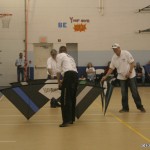The Drill Bit
A couple of weeks back, a thread popped up in the Rev Kites forum that talked at length about practice and learning curves. Given it’s something I do on a regular basis, I figured I’d talk about that in a column for a change of pace. Flyers practice for different reasons. Some simply wish to improve their skill sets or, to work on a specific move. Others are using it to better their flying in general, whether simply for the pleasure of improvement or, with a goal in mind, whether its competition or a better time with team flying. All of these and more are excellent reasons to practice.
A couple notes on what I mean by practice. I come from a music background originally. One of the things that is drilled into musicians at an early point is that practice makes perfect, and I can safely say that while I was never perfect (and likely never will be!), I also know that repetitive drilling of practice routines worked. Whether it was simply musical scales., or chord sequences, the act of repeating this kind of thing over and over again is a very effective way to make it sit permanently in your head and also, it will give your hands the muscle memory of the action, which ultimately frees your brain up to concentrate on other aspects of flying.
Joy In Repetition
When I first starting practicing scales, they bored me to tears. I won’t lie about that. But if you concentrate on the eventual benefits, you will get past that fairly quickly because the results will become obvious much sooner than you think. One of the keys to this is to choose your location and time carefully. In an ideal world, you want as few distractions as possible. Choose to go on days when you know nobody else will be around, or, go to a place where people don’t generally congregate. Make sure to set off some time as well, the ramping up of skills won’t come very quickly if you do this for 5 minutes. When I go out for the specific purpose of “practice”, I try to set aside at least an hour of time, if not two. Dress comfortably, bring some music to listen to and something to drink.
Over and Over Again
Once you are ready to go, start with something tremendously simple. Fly a straight line. No, I’m serious! Just fly a straight line. I tend to do these across the sky, doing a 180 at the edge of the window and heading back across, over and over and over again. If you can, fly in a place where there is an obvious visual cue to line up against. For me, when I am down at Vanier Park, there’s a few cues to use, such as a close by bridge for horizontal passes. Back and forth you will go but, as you do this, concentrate on the straightness of the line, plus, that your leading edge is as close to 90 degrees from the line as you can possibly make it. Now, do the same thing, but, in reverse, for as long as you did it in forward motion. And again, do these straight lines as a vertical path, spending as much time doing it in forward as in reverse. One of the things that music in your ears can help you with is speed control. Try as much as you can to make it so that each pass in any given direction is roughly taking the same amount of time (of course, reverse will take longer than forwards, so, adjust accordingly as you work on each piece). The end goal here is consistency and driving the hand control into your head so you will eventually not have to give it much thought at all, your hands will naturally get more adept at “reading” the line pressure on all four corners.
Cornering
Next up on what “seems” obviously easy but… is sharp cornering. And by that, I mean true, 90 degree corners. There’s many ways to approach this but here’s how I do it. I will fly alternating left and right boxes continuously. Its almost like flying an infinity loop but, with straight corners. For this, I’ll typically choose a very rhythmic music with a very clear beat and I’ll simply zone out into the music and cut corners on the beat. Obviously you can break this up a little bit as you do it, you don’t want to feel like some manner of robot but, again as above with straight lines, you are looking at trying to get a consistent speed between all segments of the shape you are flying. You can mix this up with other shapes as well. I’ll do a handful of squares, followed by an octagon or 10 and then go back into squares for example. Or, if you are more inclined to flying to waltzes, feel free to fly triangles! Much as with the straight lines, also focus on doing any of these in reverse as well, and while we are on the topic of shapes, go in the exact opposite direction and fly as perfect of a circle as you possibly can, timing it such that you reach the same point in the beat of the music each time around. Or, stop on the quarters. The variations are endless with this kind of work, as the idea is to simply get to be so programmed into what an accurate corner is and then be able to reliably repeat it.
Would you like a combo with that?
As John and I were discussing this article, he brought up an excellent point. Combinations of moves are also an excellent way to sharpen up flying. An excellent resource for combining the various moves in day to day flying is to study and learn the IRBC Sport Kite Compulsory Figures, inside and out. They can be found here :
http://www.aka.kite.org/?iskrb_compfigs.html
Every single one of these will push your flying ability in some way or another, whether you ever intend to compete or not.
One more thing…
If you are already flying on a team, whether as a pickup group or a dedicated group, take some time the next time you are out and identify specific things that you end up doing a lot. For me, as I am usually found at the end of the line, my biggest focus is often the diagonal line from a ball, out to the corner. I’ll do this over and over again, making sure at all times that the forward line of the burst outwards matches the same line when I am flying back into the ball, in either forward or reverse. You’ll find your own specific things that will need attention. Lastly, while I feel it’s important to do things like the exercises above repeatedly, don’t do them to the point where you are deadly dull of the whole idea. Break up the time spent out a little here and there. Just free fly for a while, or, work on axels, or landings. It all helps to bring your flying up a notch but, you don’t want to do it to a degree where flying becomes dull. Keep it light and entertaining, but remain focused at the same time. I guarantee your flying will progress very quickly in a short period of time.
Thanks, as always!
David Hathaway







